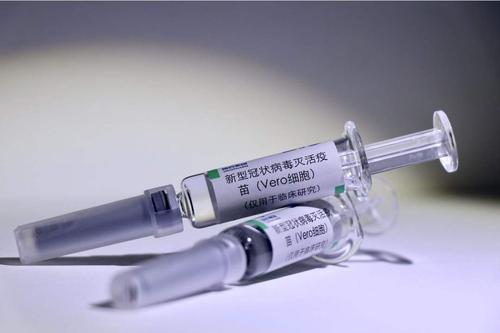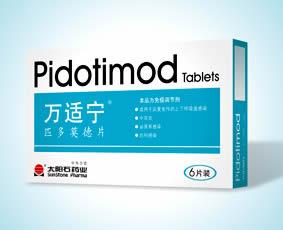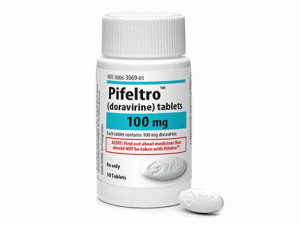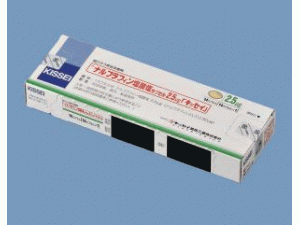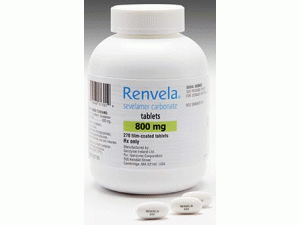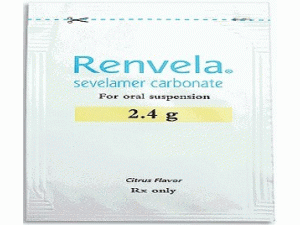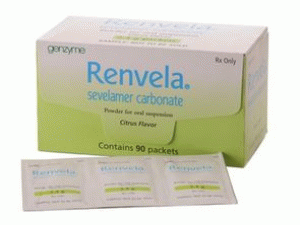盐酸达卡他韦薄膜片Daklinza(daclatasvir film-coated tablets)说明书
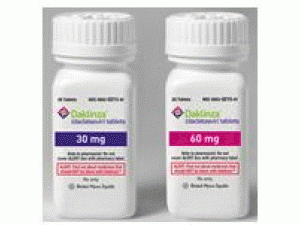 产地国家:英国
处方药:是
所属类别: 30毫克/片 28片/盒
包装规格: 30毫克/片 28片/盒
计价单位:盒
生产厂家英文名:BMS
原产地英文商品名:Daklinza film-coated Tablets 30mg/Tablets 28Tabs
原产地英文药品名:daclatasvir
中文参考商品译名:Daklinza薄膜包衣片 30毫克/片 28片/盒
中文参考药品译名:盐酸达卡他韦
产地国家:英国
处方药:是
所属类别: 30毫克/片 28片/盒
包装规格: 30毫克/片 28片/盒
计价单位:盒
生产厂家英文名:BMS
原产地英文商品名:Daklinza film-coated Tablets 30mg/Tablets 28Tabs
原产地英文药品名:daclatasvir
中文参考商品译名:Daklinza薄膜包衣片 30毫克/片 28片/盒
中文参考药品译名:盐酸达卡他韦
简介
欧盟批准Daclatasvir用于治疗慢性丙型肝炎欧盟委员会已经批准daclatasvir(Daklinza,施贵宝)联合其他药物治疗成人慢性丙型肝炎病毒(HCV)感染,该公司今天宣布。在6月份欧洲药品局人用药物医学委员会认可后药物获得批准。 Daclatasvir阻断NS5A,一种HCV复制所必需蛋白质的活性。它适用于HCV基因型1、2、3和4感染的成年人。在新闻稿中,该公司指出,口服daclatasvir联合索菲布韦在临床试验中的治愈率高达100%,包括晚期肝病、基因型3的患者和既往蛋白酶抑制剂治疗失败的患者。Daclatasvir是欧盟(EU)批准的第一个NS5A复合物抑制剂,与其他药物联合,与基于干扰素和利巴韦林方案治疗48周相比,其“治疗时间更短(12周或24周),”该公司表示。 纵观临床研究,基于daclatasvir的方案耐受性普遍良好、中断率低。与其它药物组合使用时daclatasvir的最常见副作用是疲劳、头痛和恶心。在不同患者人群,包括老年患者、晚期肝病患者、肝移植后患者和HIV合并感染患者中已经证明daclatasvir的安全性,该公司表示。“HCV是一个需要克服、具有挑战性的病毒,”德国汉诺威医学院胃肠、肝脏和内分泌科教授和主席Michael P. Manns博士在新闻稿中说。当与其他化合物联合时,Daclatasvir“甚至常常使最难以治疗的患者达到治愈,”他补充说。 基于daclatasvir方案的推荐方案和治疗持续时间包括:对于无肝硬化的HCV基因型1或4患者:daclatasvir加索菲布韦治疗12周。对于接受过治疗包括NS3/4A蛋白酶抑制剂的患者,考虑延长治疗至24周。 对于有代偿性肝硬化的基因1型或4患者:daclatasvir加索菲布韦治疗24周。对于既往未治疗、有肝硬化和正性预后因素IL28B CC基因型和/或基线病毒载量低的患者,考虑缩短治疗至12周。对于非常晚期肝病或其他负性预后因素比如既往治疗经历的患者,考虑加上利巴韦林治疗。 对于有代偿性肝硬化和/或治疗经历的基因型3患者:daclatasvir加索菲布韦联合利巴韦林治疗24周。 对于基因型4患者:daclatasvir治疗24周加聚乙二醇干扰素α和利巴韦林治疗24至48周。如果在治疗4周和12周时患者的HCV RNA均检测不到,方案中全部3种药物应持续治疗24周。如果患者达到HCV RNA检测不到,但不是在治疗4周和12周时均达到,应在24周时停止使用daclatasvir,聚乙二醇化干扰素α和利巴韦林持续治疗至48周的总持续时间。不推荐使用Daclatasvir单一治疗。产品特性总结在网上能获得。 daclatasvir在欧盟能否买到将取决于成员国的具体情况。英文版说明书
Daklinza film-coated tablets1. Name of the medicinal productDaklinza 30mg film-coated tabletsDaklinza 60 mg film-coated tablets2. Qualitative and quantitative compositionEach film-coated tablet contains daclatasvir dihydrochloride equivalent to 30 mg or 60 mg daclatasvir.Excipient(s) with known effect:Each 30-mg film-coated tablet contains 58 mg of lactose (as anhydrous).Each 60-mg film-coated tablet contains 116 mg of lactose (as anhydrous).For the full list of excipients, see section 6.1.3. Pharmaceutical formFilm-coated tablet (tablet).30 mg: Green biconvex pentagonal of dimensions 7.2 mm x 7.0 mm, debossed tablet with "BMS" on one side and "213" on the other side.60 mg: Light green biconvex pentagonal of dimensions 9.1 mm x 8.9 mm, debossed tablet with “BMS” on one side and “215” on the other side.4. Clinical particulars4.1 Therapeutic indicationsDaklinza is indicated in combination with other medicinal products for the treatment of chronic hepatitis C virus (HCV) infection in adults (see sections 4.2, 4.4 and 5.1).For HCV genotype specific activity, see sections 4.4 and 5.1.4.2 Posology and method of administrationTreatment with Daklinza should be initiated and monitored by a physician experienced in the management of chronic hepatitis C.PosologyThe recommended dose of Daklinza is 60 mg once daily, to be taken orally with or without meals.Daklinza must be administered in combination with other medicinal products. The Summary of Product Characteristics for the other medicinal products in the regimen should also be consulted before initiation of therapy with Daklinza.Recommended regimens and treatment duration are provided in Table 1 below (see sections 4.4 and 5.1):* For the regimen of Daklinza + sofosbuvir, data for 12-week treatment duration are available only for treatment-naïve patients with genotype 1 infection. For Daklinza + sofosbuvir with or without ribavirin, data are available for patients with advanced liver disease (≥F3) without cirrhosis (see sections 4.4 and 5.1). The recommended use of Daklinza + sofosbuvir in genotype 4 is based on extrapolation from genotype 1. For the regimen of Daklinza + peginterferon alfa + ribavirin, data are available for treatment-naïve patients (see section 5.1).The dose of ribavirin, when combined with Daklinza, is weight-based (1,000 or 1,200 mg in patients <75 kg or ≥75 kg, respectively).Dose modification, interruption and discontinuationDose modification of Daklinza to manage adverse reactions is not recommended. If treatment interruption of components in the regimen is necessary because of adverse reactions, Daklinza must not be given as monotherapy.There are no virologic treatment stopping rules that apply to the combination of Daklinza with sofosbuvir.Treatment discontinuation in patients with inadequate on-treatment virologic response during treatment with Daklinza, peginterferon alfa and ribavirinIt is unlikely that patients with inadequate on-treatment virologic response will achieve a sustained virologic response (SVR); therefore discontinuation of treatment is recommended in these patients. The HCV RNA thresholds that trigger discontinuation of treatment (i.e. treatment stopping rules) are presented in Table 2.Dose recommendation for concomitant medicinesStrong inhibitors of cytochrome P450 enzyme 3A4 (CYP3A4)The dose of Daklinza should be reduced to 30 mg once daily when coadministered with strong inhibitors of CYP3A4.Moderate inducers of CYP3A4The dose of Daklinza should be increased to 90 mg once daily when coadministered with moderate inducers of CYP3A4. See section 4.5.Missed dosesPatients should be instructed that, if they miss a dose of Daklinza, the dose should be taken as soon as possible if remembered within 20 hours of the scheduled dose time. However, if the missed dose is remembered more than 20 hours after the scheduled dose, the dose should be skipped and the next dose taken at the appropriate time.Special populationsElderlyNo dose adjustment of Daklinza is required for patients aged ≥65 years (see sections 4.4 and 5.2).Renal impairmentNo dose adjustment of Daklinza is required for patients with any degree of renal impairment (see section 5.2).Hepatic impairmentNo dose adjustment of Daklinza is required for patients with mild (Child-Pugh A, score 5-6), moderate (Child-Pugh B, score 7-9) or severe (Child-Pugh C, score ≥10) hepatic impairment. Daklinza has not been studied in patients with decompensated cirrhosis (see sections 4.4 and 5.2).Paediatric populationThe safety and efficacy of Daklinza in children and adolescents aged below 18 years have not yet been established. No data are available.Method of administrationDaklinza is to be taken orally with or without meals. Patients should be instructed to swallow the tablet whole. The film-coated tablet should not be chewed or crushed due the unpleasant taste of the active substance.4.3 ContraindicationsHypersensitivity to the active substance or to any of the excipients listed in section 6.1Coadministration with medicinal products that strongly induce cytochrome P450 3A4 (CYP3A4) and P-glycoprotein transporter (P-gp) and thus may lead to lower exposure and loss of efficacy of Daklinza. These active substances include but are not limited to phenytoin, carbamazepine, oxcarbazepine, phenobarbital, rifampicin, rifabutin, rifapentine, systemic dexamethasone, and the herbal product St John's wort (Hypericum perforatum).4.4 Special warnings and precautions for useDaklinza must not be administered as monotherapy. Daklinza must be administered in combination with other medicinal products for the treatment of chronic HCV infection (see sections 4.1 and 4.2).GeneralThe safety and efficacy of the combination of Daklinza and sofosbuvir have been eva luated in one study of limited size that did not include patients with cirrhosis. Further clinical studies with the combination are ongoing.Genotype-specific activityConcerning recommended regimens with different HCV genotypes, see section 4.2. Concerning genotype-specific virological and clinical activity, see section 5.1.Due to limited experience using sofosbuvir in combination with Daklinza in patients with genotype 1 infection and compensated cirrhosis, there are uncertainties concerning the most appropriate way to use Daklinza (duration, role of ribavirin) in such patients.Due to limitations in the pivotal study many uncertainties remain regarding the most effective way to use Daklinza for treatment of genotypes 2 and 3 infection, and how to tailor regimens according to important factors potentially affecting the virological response.Although not studied in patients with genotype 4 infection, the combination of Daklinza and sofosbuvir is expected to yield similar activity for genotype 4 as observed for genotype 1, based on in vitro antiviral activity and available clinical data with Daklinza in combination with peginterferon and ribavirin (see section 5.1).Daklinza has not been studied in patients with HCV genotypes 5 and 6, and no regimen recommendation can be given.Decompensated liver diseaseThe safety and efficacy of Daklinza in the treatment of HCV infection in patients with decompensated liver disease have not been established.Retreatment with daclatasvirThe efficacy of Daklinza as part of a retreatment regimen in patients with prior exposure to a NS5A inhibitor has not been established.Pregnancy and contraception requirementsDaklinza should not be used during pregnancy or in women of childbearing potential not using contraception. Use of highly effective contraception should be continued for 5 weeks after completion of Daklinza therapy (see section 4.6).When Daklinza is used in combination with ribavirin, the contraindications and warnings for that medicinal product are applicable. Significant teratogenic and/or embryocidal effects have been demonstrated in all animal species exposed to ribavirin; therefore, extreme care must be taken to avoid pregnancy in female patients and in female partners of male patients (see the Summary of Product Characteristics for ribavirin).Organ transplant patientsThe safety and efficacy of Daklinza in the treatment of HCV infection in patients who are pre-, peri-, or post-liver transplant or other organ transplant patients have not been established.HCV/HIV (human immunodeficiency virus) co-infectionThe safety and efficacy of Daklinza in the treatment of HCV infection in patients who are co-infected with HIV have not been established.HCV/HBV (hepatitis B virus) co-infectionThe safety and efficacy of Daklinza in the treatment of HCV infection in patients who are co-infected with HBV have not been investigated.ElderlyClinical data in patients aged ≥65 years are limited. In clinical studies of Daklinza in combination with sofosbuvir or with peginterferon alfa and ribavirin, no differences in responses were observed between elderly and younger patients.Interactions with medicinal productsCoadministration of Daklinza can alter the concentration of other medicinal products and other medicinal products may alter the concentration of daclatasvir. Refer to section 4.3 for a listing of medicinal products that are contraindicated for use with Daklinza due to potential loss of therapeutic effect. Refer to section 4.5 for established and other potentially significant drug-drug interactions.Paediatric populationDaklinza is not recommended for use in children and adolescents aged below 18 years because the safety and efficacy have not been established in this population.Important information about some of the ingredients in DaklinzaDaklinza contains lactose. Patients with rare hereditary problems of galactose intolerance, the Lapp lactase deficiency or glucose-galactose malabsorption should not take this medicine.4.5 Interaction with other medicinal products and other forms of interactionContraindications of concomitant use (see section 4.3)Daklinza is contraindicated in combination with medicinal products that strongly induce CYP3A4 and P-gp, e.g. phenytoin, carbamazepine, oxcarbazepine, phenobarbital, rifampicin, rifabutin, rifapentine, systemic dexamethasone, and the herbal product St John's wort (Hypericum perforatum), and thus may lead to lower exposure and loss of efficacy of Daklinza.Potential for interaction with other medicinal productsDaclatasvir is a substrate of CYP3A4 and P-gp. Strong or moderate inducers of CYP3A4 and P-gp may decrease the plasma levels and therapeutic effect of daclatasvir. Coadministration with strong inducers of CYP3A4 and P-gp is contraindicated while dose adjustment of Daklinza is recommended when coadministered with moderate inducers of CYP3A4 and P-gp (see Table 3). Strong inhibitors of CYP3A4 may increase the plasma levels of daclatasvir. Dose adjustment of Daklinza is recommended when coadministered with strong inhibitors of CYP3A4 (see Table 3). Coadministration of medicines that inhibit P-gp activity is likely to a have limited effect on daclatasvir exposure.Daclatasvir is an inhibitor of P-gp, organic anion transporting polypeptide (OATP) 1B1, organic cation transporter (OCT)1 and breast cancer resistance protein (BCRP). Administration of Daklinza may increase systemic exposure to medicinal products that are substrates of P-gp, OATP 1B1, OCT1 or BCRP, which could increase or prolong their therapeutic effect and adverse reactions. Caution should be used if the medicinal product has a narrow therapeutic range (see Table 3).Daclatasvir is a very weak inducer of CYP3A4 and caused a 13% decrease in midazolam exposure. However, as this is a limited effect, dose adjustment of concomitantly administered CYP3A4 substrates is not necessary.Refer to the respective Summary of Product Characteristics for drug interaction information for other medicinal products in the regimen.Tabulated summary of interactionsTable 3 provides information from drug interaction studies with daclatasvir including clinical recommendations for established or potentially significant drug interactions. Clinically relevant increase in concentration is indicated as “↑”, clinically relevant decrease as “↓”, no clinically relevant change as “↔”. If available, ratios of geometric means are shown, with 90% confidence intervals (CI) in parentheses. The studies presented in Table 3 were conducted in healthy adult subjects unless otherwise noted. The table is not all-inclusive.No clinically relevant effects on the pharmacokinetics of either medicinal product are expected when daclatasvir is coadministered with any of the following: PDE-5 inhibitors, medicinal products in the ACE inhibitor class (e.g. enalapril), medicinal products in the angiotensin II receptor antagonist class (e.g. losartan, irbesartan, olmesartan, candesartan, valsartan), amiodarone, disopyramide, propafenone, flecainide, mexilitine, quinidine or antacids.Paediatric populationInteraction studies have only been performed in adults.4.6 Fertility, pregnancy and lactationPregnancyThere are no data from the use of daclatasvir in pregnant women.Studies of daclatasvir in animals have shown embryotoxic and teratogenic effects (see section 5.3). The potential risk for humans is unknown.Daklinza should not be used during pregnancy or in women of childbearing potential not using contraception (see section 4.4). Use of highly effective contraception should be continued for 5 weeks after completion of Daklinza therapy (see section 4.5).Since Daklinza is used in combination with other agents, the contraindications and warnings for those medicinal products are applicable.For detailed recommendations regarding pregnancy and contraception, refer to the Summary of Product Characteristics for ribavirin and peginterferon alfa.Breast-feedingIt is not known whether daclatasvir is excreted in human milk. Available pharmacokinetic and toxicological data in animals have shown excretion of daclatasvir and metabolites in milk (see section 5.3). A risk to the newborn/infant cannot be excluded. Mothers should be instructed not to breastfeed if they are taking Daklinza.FertilityNo human data on the effect of daclatasvir on fertility are available.In rats, no effect on mating or fertility was seen (see section 5.3).4.7 Effects on ability to drive and use machinesDizziness has been reported during treatment with Daklinza in combination with sofosbuvir, and dizziness, disturbance in attention, blurred vision and reduced visual acuity have been reported during treatment with Daklinza in combination with peginterferon alfa and ribavirin.4.8 Undesirable effectsSummary of the safety profileThe overall safety profile of daclatasvir is based on data from 798 patients with chronic HCV infection who received Daklinza 60 mg once daily either in combination with sofosbuvir with or without ribavirin (n=211) or in combination with peginterferon alfa and ribavirin (n=587, pooled data) from a total of eight clinical trials.Daklinza in combination with sofosbuvirThe most frequently reported adverse reactions were fatigue, headache, and nausea. No Grade 3 or 4 adverse reactions were reported. Two patients discontinued for adverse events, which were considered unrelated to study therapy.Daklinza in combination with peginterferon alfa and ribavirinThe most frequently reported adverse reactions were fatigue, headache, pruritus, insomnia, influenza-like illness, dry skin, nausea, decreased appetite, alopecia, rash, asthenia, irritability, myalgia, anaemia, pyrexia, cough, dyspnoea, neutropenia, diarrhoea and arthralgia. The most frequently reported adverse reactions of at least Grade 3 severity (frequency of 1% or greater) were neutropenia, anaemia and lymphopenia. The safety profile of daclatasvir in combination with peginterferon alfa and ribavirin was similar to that seen with peginterferon alfa and ribavirin alone, including among patients with cirrhosis.Tabulated list of adverse reactionsAdverse reactions are listed in Table 4 by system organ class and frequency: very common (≥1/10), common (≥1/100 to <1/10), uncommon (≥1/1,000 to <1/100), rare (≥1/10,000 to <1/1,000) and very rare (<1/10,000). Within each frequency grouping, adverse reactions are presented in order of decreasing seriousness.* Ninety (43%) of the 211 patients received ribavirin in addition to Daklinza and sofosbuvir. There were no reports of anaemia in the ribavirin-free treatment groups of the study.Laboratory abnormalitiesIn the clinical trial of Daklinza in combination with sofosbuvir with or without ribavirin, one patient had a Grade 3 hemoglobin decrease; this patient was in a ribavirin treatment group. Laboratory abnormalities among patients treated with Daklinza, peginterferon alfa and ribavirin were similar to those among patients treated with placebo, peginterferon and ribavirin.Paediatric populationThe safety and efficacy of Daklinza in children and adolescents aged <18 years have not yet been established. No data are available.Reporting of suspected adverse reactionsReporting suspected adverse reactions after authorisation of the medicinal product is important. It allows continued monitoring of the benefit/risk balance of the medicinal product. Healthcare professionals are asked to report any suspected adverse reactions via the Yellow Card Scheme at: www.mhra.gov.uk/yellowcard.4.9 OverdoseThere is limited experience of accidental overdose of daclatasvir in clinical trials. In phase 1 clinical trials, healthy subjects who received up to 100 mg once daily for up to 14 days or single doses up to 200 mg had no unexpected adverse reactions.There is no known antidote for overdose of daclatasvir. Treatment of overdose with daclatasvir should consist of general supportive measures, including monitoring of vital signs, and observation of the patient's clinical status. Because daclatasvir is highly protein bound (99%) and has a molecular weight >500, dialysis is unlikely to significantly reduce plasma concentrations of daclatasvir.5. Pharmacological properties5.1 Pharmacodynamic propertiesPharmacotherapeutic group: ATC code: not yet assignedMechanism of actionDaclatasvir is an inhibitor of nonstructural protein 5A (NS5A), a multifunctional protein that is an essential component of the HCV replication complex. Daclatasvir inhibits both viral RNA replication and virion assembly.Antiviral activity in cell cultureDaclatasvir is an inhibitor of HCV genotypes 1a and 1b replication in cell-based replicon assays with effective concentration (50% reduction, EC50) values of 0.003-0.050 and 0.001-0.009 nM, respectively, depending on the assay method. The daclatasvir EC50 values in the replicon system were 0.003-1.25 nM for genotypes 3a, 4a, 5a and 6a, and 0.034-19 nM for genotype 2a as well as 0.020 nM for infectious genotype 2a (JFH-1) virus.Daclatasvir showed additive to synergistic interactions with interferon alfa, HCV nonstructural protein 3 (NS3) protease inhibitors, HCV nonstructural protein 5B (NS5B) non-nucleoside inhibitors, and HCV NS5B nucleoside analogues in combination studies using the cell-based HCV replicon system. No antagonism of antiviral activity was observed.No clinically relevant antiviral activity was observed against a variety of RNA and DNA viruses, including HIV, confirming that daclatasvir, which inhibits a HCV-specific target, is highly selective for HCV.Resistance in cell cultureSubstitutions conferring daclatasvir resistance in genotypes 1-4 were observed in the N-terminal 100 amino acid region of NS5A in a cell-based replicon system. L31V and Y93H were frequently observed resistance substitutions in genotype 1b, while M28T, L31V/M, Q30E/H/R, and Y93C/H/N were frequently observed resistance substitutions in genotype 1a. These substitutions conferred low level resistance (EC50 <1 nM) for genotype 1b, and higher levels of resistance for genotype 1a (EC50 up to 350 nM). The most resistant variants with single amino acid substitution in genotype 2a and genotype 3a were F28S (EC50 >300 nM) and Y93H (EC50 >1,000 nM), respectively. Polymorphisms observed in genotype 4a did not appear to impact the potency of daclatasvir (EC50 0.007-0.0013 nM); residues 30 and 93 were the most frequently observed variants, and levels of resistance were low to moderate (EC50 0.9-16 nM).Cross-resistanceHCV replicons expressing daclatasvir-associated resistance substitutions remained fully sensitive to interferon alfa and other anti-HCV agents with different mechanisms of action, such as NS3 protease and NS5B polymerase (nucleoside and non-nucleoside) inhibitors.Clinical efficacy and safetyIn clinical studies of Daklinza in combination with sofosbuvir or with peginterferon alfa and ribavirin, plasma HCV RNA values were measured using the COBAS TaqMan HCV test (version 2.0), for use with the High Pure System, with a lower limit of quantification (LLOQ) of 25 IU/ ml. SVR was the primary endpoint to determine the HCV cure rate, which was defined as HCV RNA less than LLOQ at 12 weeks after the end of treatment (SVR12) for AI444040 and AI444042 and as HCV RNA undetectable at 24 weeks after the end of treatment (SVR24) for study AI444010.Daclatasvir in combination with sofosbuvirThe efficacy and safety of daclatasvir 60 mg once daily in combination with sofosbuvir 400 mg once daily, with or without ribavirin, in the treatment of infection with chronic HCV genotype 1, 2, or 3 were eva luated in an open-label randomized study (AI444040) in 211 adults without cirrhosis. Among the 167 patients with HCV genotype 1 infection, 126 were treatment-naïve and 41 had failed prior therapy with a protease inhibitor (PI) regimen (boceprevir or telaprevir). All 44 patients with HCV genotype 2 (n=26) or 3 (n=18) infection were treatment-naïve. Treatment duration was 12 weeks for 82 treatment-naïve HCV genotype 1 patients, and 24 weeks for all other patients in the study. The 211 patients had a median age of 54 years (range: 20 to 70); 83% were white; 12% were black/African-American; 2% were Asian; 20% were Hispanic or Latino. The mean score on the FibroTest (a validated non-invasive diagnostic assay) was 0.460 (range: 0.03 to 0.89). Conversion of the FibroTest score to the corresponding METAVIR score suggests that 35% of all patients (49% of patients with prior PI failure, 30% of patients with genotype 2 or 3) had ≥F3 liver fibrosis. Most patients (71%, including 98% of prior PI failures) had IL-28B rs12979860 non-CC genotypes.SVR12 was achieved by 99% patients with HCV genotype 1, 96% of those with genotype 2 and 89% of those with genotype 3 (see Tables 5 and 6). Response was rapid (viral load at Week 4 showed that more than 97% of patients responded to therapy), and was not influenced by HCV subtype (1a/1b), IL28B genotype, or use of ribavirin. Among treatment-naïve patients with HCV RNA results at both follow-up Weeks 12 and 24, concordance between SVR12 and SVR24 was 99.5% independent of treatment duration.Treatment-naïve patients with HCV genotype 1 who received 12 weeks of treatment had a similar response as those treated for 24 weeks (Table 5).* Patients who had missing data at follow-up Week 12 were considered responders if their next available HCV RNA value was 1 log10 from nadir or any confirmed HCV RNA ≥LLOQ after confirmed undetectable while on treatment), patients who met the protocol-defined treatment futility criteria, and patients with missing or detectable HCV RNA at end of treatment. Relapse was defined as confirmed detectable HCV RNA ≥LLOQ during follow-up among patients with HCV undetectable at end of treatment.Long term efficacy dataLimited data are available from an ongoing follow-up study to assess durability of response up to 3 years after treatment with daclatasvir. Among patients who achieved SVR12 with daclatasvir and sofosbuvir (± ribavirin) with a median duration of post-SVR12 follow-up of 15 months, no relapses have occurred. Among patients who achieved SVR12 with daclatasvir + pegIFN/RBV with a median duration of post-SVR12 follow-up of 22 months, 1% of patients relapsed.Resistance in clinical studiesDaclatasvir in combination with sofosbuvirIn study AI444040, baseline NS5A polymorphisms known to reduce susceptibility to inhibition by daclatasvir in vitro were detected in 16% (33/203) of subjects (9/130 genotype 1a, 4/32 genotype 1b, 14/23 genotype 2, and 6/18 genotype 3). These NS5A resistance-associated polymorphisms (RAPs) included M28T, Q30E/H/R, L31M, and Y93C/H/N in genotype 1a subjects; L31M and Y93H in genotype 1b subjects; L31M in genotype 2 subjects; and A30K/S, L31M, and Y93H in genotype 3 subjects.Except for a single patient infected with genotype 3 who experienced viral relapse after treatment with daclatasvir and sofosbuvir without ribavirin, all patients with pre-existing daclatasvir resistant variants achieved SVR. Resistance analysis of the one genotype 3-infected patient who relapsed revealed no other resistance-associated changes at relapse other than the pre-existing NS5A-A30K-S62I/V polymorphisms.Daclatasvir in combination with peginterferon alfa and ribavirinPretreatment NS5A polymorphisms known to confer loss of daclatasvir susceptibility in vitro (genotype 1a: M28T, Q30H/R, L31M/V, Y93H/N; genotype 1b: L31M, Y93C/H; genotype 4: L28M, L30R, M31V) were observed in 9/125 (7%) genotype 1a, 8/50 (16%) genotype 1b, and 57/94 (61%) genotype 4 treatment-naïve patients. The majority of patients (5/9 [56%] genotype 1a, 6/8 [75%] genotype 1b and 52/57 [91%] genotype 4 patients) with these pretreatment NS5A RAPs achieved SVR.In 210 (153 genotype 1a and 57 genotype 1b) treatment-naïve patients and prior nonresponders who experienced treatment failure, NS5A resistance-associated variants generally emerged (139/153 genotype 1a and 49/57 genotype 1b). The most frequently detected NS5A variants included Q30E or Q30R in combination with L31M. The majority of genotype 1a failures had emergent NS5A variants detected at Q30 (127/139 [91%]), and the majority of genotype 1b failures had emergent NS5A variants detected at L31 (37/49 [76%]) and/or Y93H (34/49 [69%]). These NS5A variants were detected together in 36/49 (74%) of patients at failure and either emerged together ( 25/36 [69%] of patients with L31M/V-Y93H) or if one emerged, the other pre-existed (11/36 [31%] patients).In 133 (103 genotype 1a and 30 genotype 1b) treatment-naïve patients and prior nonresponders who did not achieve SVR24 and were monitored at 48 weeks post-treatment, signature genotype 1a and genotype 1b NS5A resistance-associated variants generally persisted; replacement by wild-type sequence was detected in 2/133 (2%; 2/103 genotype 1a and 0/30 genotype 1b patients) of virologic failures.Paediatric populationThe European Medicines Agency has deferred the obligation to submit the results of studies with Daklinza in one or more subsets of the paediatric population in the treatment of chronic hepatitis C (see section 4.2 for information on paediatric use).5.2 Pharmacokinetic propertiesThe pharmacokinetic properties of daclatasvir were eva luated in healthy adult subjects and in subjects with chronic HCV. Following multiple oral doses of daclatasvir 60 mg once daily in combination with peginterferon alfa and ribavirin in treatment-naïve subjects with genotype 1 chronic HCV, the geometric mean (CV%) daclatasvir Cmax was 1534 (58) ng/ml, AUC0-24h was 14122 (70) ng•h/ml, and Cmin was 232 (83) ng/ml.AbsorptionDaclatasvir administered as a tablet was readily absorbed following multiple oral doses with peak plasma concentrations occurring between 1 and 2 hours.Daclatasvir Cmax, AUC, and Cmin increased in a near dose-proportional manner. Steady state was achieved after 4 days of once-daily administration. At the 60 mg dose, exposure to daclatasvir was similar between healthy and HCV-infected subjects.In vitro and in vivo studies showed that daclatasvir is a substrate of P-gp. The absolute bioavailability of the tablet formulation is 67%.Effect of food on oral absorptionIn healthy subjects, administration of daclatasvir 60 mg tablet after a high-fat meal decreased daclatasvir Cmax and AUC by 28% and 23%, respectively, compared with administration under fasting conditions. Administration of daclatasvir 60 mg tablet after a light meal resulted in no reduction in daclatasvir exposure.DistributionAt steady state, protein binding of daclatasvir in HCV-infected subjects was approximately 99% and independent of dose at the dose range studied (1 mg to 100 mg). In subjects who received daclatasvir 60 mg tablet orally followed by 100 μg [13C,15N]-daclatasvir intravenous dose, estimated volume of distribution at steady state was 47 l.Daclatasvir is an inhibitor of P-gp, OATP 1B1 and BCRP. In vitro daclatasvir is an inhibitor of renal uptake transporters, organic anion transporters (OAT) 1 and 3, and OCT2, but is not expected to have a clinical effect on the pharmacokinetics of substrates of these transporters.BiotransformationIn vitro and in vivo studies demonstrate that daclatasvir is a substrate of CYP3A, with CYP3A4 being the major CYP isoform responsible for the metabolism. No metabolites circulated at levels more than 5% of the parent concentration. Daclatasvir in vitro did not inhibit (IC50 >40 µM) CYP enzymes 1A2, 2B6, 2C8, 2C9, 2C19, or 2D6.EliminationFollowing single-dose oral administration of 14C–daclatasvir in healthy subjects, 88% of total radioactivity was recovered in feces (53% as unchanged drug) and 6.6% was excreted in the urine (primarily as unchanged drug). Following multiple-dose administration of daclatasvir in HCV-infected subjects, the terminal elimination half-life of daclatasvir ranged from 12 to 15 hours. In subjects who received daclatasvir 60 mg tablet orally followed by 100 μg [13C,15N]-daclatasvir intravenous dose, the total clearance was 4.24 l/h.Special populationsRenal impairmentThe pharmacokinetics of daclatasvir following a single 60 mg oral dose were studied in non-HCV infected subjects with renal impairment. Daclatasvir unbound AUC was estimated to be 18%, 39% and 51% higher for subjects with creatinine clearance (CLcr) values of 60, 30 and 15 ml/min, respectively, relative to subjects with normal renal function. Subjects with end-stage renal disease requiring hemodialysis had a 27% increase in daclatasvir AUC and a 20% increase in unbound AUC compared to subjects with normal renal function (see section 4.2).Hepatic impairmentThe pharmacokinetics of daclatasvir following a single 30 mg oral dose were studied in non-HCV infected subjects with mild (Child-Pugh A), moderate (Child-Pugh B), and severe (Child-Pugh C) hepatic impairment compared with unimpaired subjects. The Cmax and AUC of total daclatasvir (free and protein-bound drug) were lower in subjects with hepatic impairment; however, hepatic impairment did not have a clinically significant effect on the free drug concentrations of daclatasvir (see section 4.2).ElderlyPopulation pharmacokinetic analysis of data from clinical trials indicated that age had no apparent effect on the pharmacokinetics of daclatasvir. Data on patients ≥65 years are limited (see section 4.4).Paediatric populationThe pharmacokinetics of daclatasvir in paediatric patients have not been eva luated.GenderPopulation pharmacokinetic analysis identified gender as a statistically significant covariate on daclatasvir apparent oral clearance (CL/F) with female subjects having slightly lower CL/F, but the magnitude of the effect on daclatasvir exposure is not clinically important.RacePopulation pharmacokinetic analysis of data from clinical trials identified race (categories “other” [subjects who are not white, black or Asian] and “black”) as a statistically significant covariate on daclatasvir apparent oral clearance (CL/F) and apparent volume of distribution (Vc/F) resulting in slightly higher exposures compared to white subjects, but the magnitude of the effect on daclatasvir exposure is not clinically important.5.3 Preclinical safety dataToxicologyIn repeat-dose toxicology studies in animals, hepatic effects (Kupffer-cell hypertrophy/ hyperplasia, mononuclear cell infiltrates and bile duct hyperplasia) and adrenal gland effects (changes in cytoplasmic vacuolation and adrenal cortical hypertrophy/hyperplasia) were observed at exposures similar or slightly higher than the clinical AUC exposure. In dogs, bone marrow hypocellularity with correlating clinical pathology changes were observed at exposures 9-fold the clinical AUC exposure. None of these effects have been observed in humans.Carcinogenesis and mutagenesisDaclatasvir was not carcinogenic in mice or in rats at exposures 8-fold or 4-fold, respectively, the clinical AUC exposure. No evidence of mutagenic or clastogenic activity was observed in in vitro mutagenesis (Ames) tests, mammalian mutation assays in Chinese hamster ovary cells, or in an in vivo oral micronucleus study in rats.FertilityDaclatasvir had no effects on fertility in female rats at any dose tested. The highest AUC value in unaffected females was 18-fold the clinical AUC exposure. In male rats, effects on reproductive endpoints were limited to reduced prostate/seminal vesicle weights, and minimally increased dysmorphic sperm at 200 mg/kg/day; however, neither finding adversely affected fertility or the number of viable conceptuses sired. The AUC associated with this dose in males is 19-fold the clinical AUC exposure.Embryo-foetal developmentDaclatasvir is embryotoxic and teratogenic in rats and rabbits at exposures at or above 4-fold (rat) and 16-fold (rabbit) the clinical AUC exposure. Developmental toxicity consisted of increased embryofoetal lethality, reduced foetal body weights and increased incidence of foetal malformations and variations. In rats, malformations mainly affected the brain, skull, eyes, ears, nose, lip, palate or limbs and in rabbits, the ribs and cardiovascular area. Maternal toxicity including mortality, abortions, adverse clinical signs, decreases in body weight and food consumption was noted in both species at exposures 25-fold (rat) and 72-fold (rabbit) the clinical AUC exposure.In a study of pre- and postnatal development in rats, there was neither maternal nor developmental toxicity at doses up to 50 mg/kg/day, associated with AUC values 2-fold the clinical AUC exposure. At the highest dose (100 mg/kg/day), maternal toxicity included mortality and dystocia; developmental toxicity included slight reductions in offspring viability in the peri- and neonatal periods; and reductions in birth weight that persisted into adulthood. The AUC value associated with this dose is 4-fold the clinical AUC exposure.Excretion into milkDaclatasvir was excreted into the milk of lactating rats with concentrations 1.7- to 2-fold maternal plasma levels.6. Pharmaceutical particulars6.1 List of excipientsTablet coreAnhydrous lactoseMicrocrystalline celluloseCroscarmellose sodiumSilicon dioxide (E551)Magnesium stearateTablet film-coatHypromelloseTitanium dioxide (E171)Macrogol 400Indigo carmine aluminum lake (E132)Yellow iron oxide (E172)6.2 IncompatibilitiesNot applicable.6.3 Shelf life30 months6.4 Special precautions for storageThis medicinal product does not require any special storage conditions.6.5 Nature and contents of containerPolyvinyl Chloride/poly-chloro-tri-fluoro-ethylene (PVC/PCTFE) clear blister/aluminum foil lidding.Pack size of 28 film-coated tablets in perforated unit dose blisters.Pack size of 28 film-coated tablets in non-perforated calendar blisters.Not all pack sizes may be marketed.6.6 Special precautions for disposal and other handlingAny unused medicinal product or waste material should be disposed of in accordance with local requirements.7. Marketing authorisation holderBristol-Myers Squibb Pharma EEIGUxbridge Business ParkSanderson RoadUxbridge UB8 1DHUnited Kingdom8. Marketing authorisation number(s)EU/1/14/939/002EU/1/14/939/0049. Date of first authorisation/renewal of the authorisationDate of first authorisation: 22 August 201410. Date of revision of the textAugust 2014Detailed information on this medicinal product is available on the website of the European Medicines Agency用药温馨提示:当您服用此药物时,需定期接受医疗专业人士的检查,以便随时针对其药效、副作用等情况进行监测。本网站所包含的信息旨在为患者提供帮助,不能代替医学建议和治疗。
药品价格查询,专业药品查询网站,药品说明书查询,药品比价 » 盐酸达卡他韦薄膜片Daklinza(daclatasvir film-coated tablets)说明书
药品价格查询,专业药品查询网站,药品说明书查询,药品比价 » 盐酸达卡他韦薄膜片Daklinza(daclatasvir film-coated tablets)说明书

